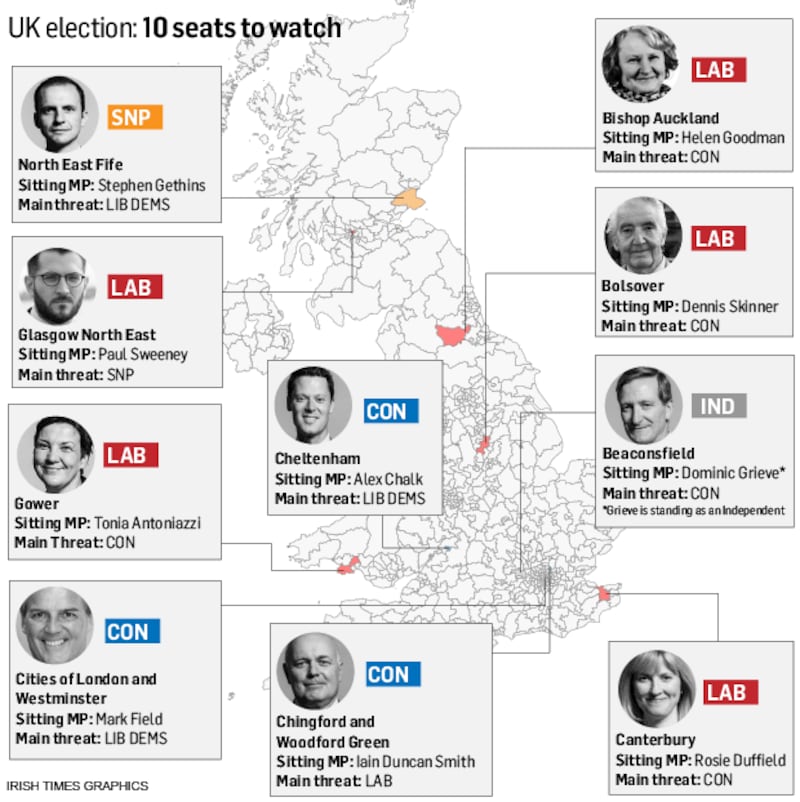The UK general election officially began on Wednesday following the dissolution of parliament at midnight. Here are ten battleground constituencies to watch in the run-up to polling day, December 12th. These are the seats where the election is likely to be won and lost.
Bishop Auckland
This constituency in a former mining district in County Durham has never elected a Conservative MP but Labour's Helen Goodman came within 500 votes of losing it in 2017. This is one of the Tories' top targets and if they fail to capture Bishop Auckland, Boris Johnson's strategy of capturing Leave-voting seats in Labour's old heartland will almost certainly have failed.

Bolsover
At 87, Dennis Skinner is Labour's longest-serving MP, representing this Derbyshire seat since 1970. But his majority has shrunk to just over 5,000 and although Skinner campaigned to leave the EU, he faces a strong challenge from the Conservatives. The Brexit Party could be decisive in this Leave-voting seat, with the potential to take votes from both Labour and the Tories.
Cheltenham
Conservative Alex Chalk is defending a majority of just over 2,500 in this affluent, Remain-voting constituency, a prime target for the Liberal Democrats. His fate could hinge on Boris Johnson's success in reassuring moderate Conservatives that he will push his Brexit deal through parliament and that a no-deal exit is firmly off the table.
Beaconsfield
The Liberal Democrats are stepping aside in favour of former Conservative attorney general Dominic Grieve, who is standing as an Independent following his loss of the Tory whip over Brexit. This Buckinghamshire seat will test the strength of anti-Brexit feeling among traditional, moderate Conservatives and the effectiveness of tactical voting in a polarised contest.
Cities of London and Westminster
The Liberal Democrats came a distant third in 2017 but they believe their candidate, former Labour frontbencher Chuka Umunna, can leapfrog the two main parties in this Remain-voting seat. Conservative MP Mark Field, who apologised last June after he gripped a female protester by the neck as he frogmarched her out of a black tie dinner, is stepping down. The Conservatives hope Umunna will help them to hold the seat by splitting the anti-Brexit vote.
Canterbury
One of a number of unexpected Labour gains in 2017, this seat has a big student population and an electorate that opposed Brexit. For Rosie Duffield to hold it, she will need to persuade passionate Remain voters to stick with Labour despite Jeremy Corbyn's nuanced approach to Brexit.
North East Fife
The most marginal seat in the country, where the SNP's Stephen Gethins has a majority of two votes. The Liberal Democrats are hoping to capture the seat but the Conservatives, who won more than 10,000 votes here in 2017, will also be watching it closely as an indication of how their vote holds up across Scotland.
Glasgow North East
The only sitting Labour MP in a city that was once a stronghold, Paul Sweeney has a majority of just 242. The SNP, which held the seat from 2015 to 2017, is determined to get it back and Sweeney's survival would be an important sign that there is some life left in Labour in Scotland.
Gower
One of a number of target seats for the Conservatives in Wales, the only constituent part of the UK apart from England to vote Leave in the 2016 Brexit referendum. Tory hopes took a hit last weekend when it emerged that their candidate Francesca O'Brien had once suggested that social welfare claimants featured in the TV series Benefits Street should be "put down".
Chingford and Woodford Green
With a majority of less than 2,500, former Conservative leader Iain Duncan Smith is vulnerable in this London seat to Labour's Faiza Shaheen, an economist who joined the party after Corbyn became leader in 2015. This contest will test the effectiveness of Labour's ground campaign, which has been organising since the last election in its effort to unseat Duncan Smith, one of the most high-profile Conservatives at risk.












